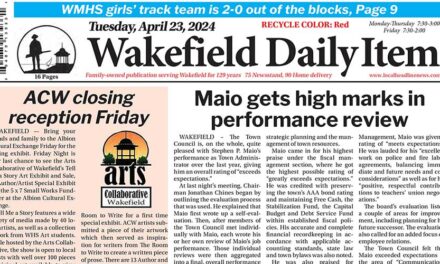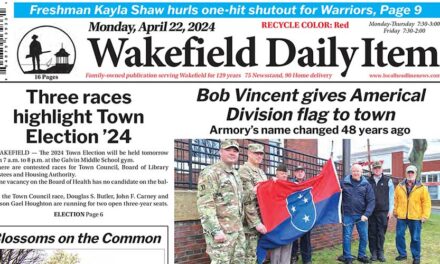Published in the December 14, 2018 edition.
By MARK SARDELLA
WAKEFIELD — The pros and cons of the Wakefield Public Schools’ Learn Anywhere Project were hashed out at a recent School Committee meeting as part of a presentation by a committee charged with evaluating the program.
The Learn Anywhere Project consists of three parts: Distance learning during school cancellation days; offering online, blended course electives with a partner high school; and personalizing summer learning opportunities. The focus of the Learn Anywhere Committee’s recent presentation and the subsequent discussion was the distance learning on snow days component.
Under the Learn Anywhere program, when school is cancelled on snow days, students are expected to complete school assignments at home. Students access assignments using either Google Classroom of the Learn Anywhere web site. Teachers post learning expectations no later than the morning of the cancelled school day, but may prepare and post assignments earlier.
As a result of the Learn Anywhere Project, school days cancelled due to snow do not have to be made up at the end of the school year.
Considered a pilot program, the Learn Anywhere Project began with the 2017-2018 school year. Last June, the School Committee voted to continue the pilot program for two more years. At the same time, they decided to form the Learn Anywhere Committee to evaluate and recommend improvements to the program.
Headed by Assistant Superintendent Kara Mauro and Wakefield Academy Director Matthew Carter, membership on the 12-member Learn Anywhere Committee includes both teachers and parents. Mauro and Carter reported to the School Committee that the Learn Anywhere Committee had met three times during the fall as well as communicating with each other in between meetings via email and phone.
Carter reviewed the results of a survey of students and parents conducted last spring, at the end of the first year of the program.
About 95 percent of elementary and middle school students said that their teachers had provided them with clear directions for what they needed to do on Learn Anywhere snow days. About 77 percent of high school students felt that expectations were made clear by teachers. About 87 percent of parents felt that Learn Anywhere Assignments were clear.
Asked if their teachers checked to see if learn Anywhere assignments were completed and provided feedback, 75 percent of elementary students answered in the affirmative as did 87 percent of middle school students and 63 percent of high school students. Sixty percent of parents responded that their child’s Learn Anywhere work was checked.
Asked if they knew how to reach their teacher during a snow day if they needed help or guidance on an assignment, 56 percent of elementary students said that they did, along with 89 percent of middle school students and 75 percent of high school students. Eighty-three percent of parents said that their children knew how to reach their teachers for help on a snow day.
Fifty-nine percent of elementary students said that they found their Learn Anywhere assignments interesting, as did 62 percent of middle school students and 48 percent of high school students. Seventy-four percent of parents felt that their kids’ Learn Anywhere assignments were interesting.
Asked if their Learn Anywhere snow day assignments were related to what they were learning in school, 77 percent of elementary students said yes, along with 83 percent of middle school and 73 percent of high school students. Eighty-three percent of parents agreed.
Mauro and Carter discussed the positives of the Learn Anywhere program as well as areas for improvement based on the committee’s analysis of the survey results.
Learn Anywhere was called “an innovative program, responding to the various ways students learn.” Another plus was the fact that the last day of school was firmly set and communicated.
Assignments were seen as easily accessible, via the Learn Anywhere website or other accessible method.
Areas of needing improvement were also identified by the committee.
Students requiring school-based services (IEP/ELL, etc.) were unable to access them consistently during the weather-related event. The committee felt that assignments did not consistently align with the curriculum mapping and more attention was needed in the areas of rigor and feedback.
Among the recommendations that the committee made for the elementary school level were fewer computer-based assignments. Parents of younger children expressed a desire for less screen time for their children. Another recommendation was providing additional support for elementary school parents.
At the secondary school level, the recommendations included:
Setting Clear and consistent deadlines.Exploring options around grading and how credit is received for completing the assignment.Exploring options for teacher availability.Relevant assignments — related to activities being covered in class at the time of the Learn Anywhere event.Differentiated assignments — provide options to complete tasks at students’ independent learning levels.Mauro also talked about the need for more attention to groups not being as well-served by the Learn Anywhere program as they could be, including Special Education students. She also stressed the need to make sure that non-English speaking students understand assignments and get translations where needed.
A Learn Anywhere trial was conducted earlier in the current school year to make sure that students were able to access assignments. A survey conducted after the trial showed that a high percentage of parents felt that the assignments were easy to find and understand and that students understood how to contact their teachers on Learn Anywhere snow days.
Learn Anywhere Committee member Suzy Veilleux said that she believed that with clearer communication of expectations to students, teachers and parents, satisfaction with the Learn Anywhere program would continue to rise.
Another parent member of the committee, Amy Leeman, said that distance learning does not meet the depth and scope of classroom learning. She also felt that elementary students need play-based learning, peer modeling, collaboration and community building – none of which can be done from a remote location.
School Committee member Christopher Callanan suggested that the volume of work on a Learn Anywhere snow day should not be equated to a school day in January, but rather to a late June school day.
School Committee member Greg Liakos stressed that in any pilot program there were bound to be places where additional work and improvement is needed.
School Committee member Anne Fortier talked about the importance of communication with parents and letting them know that Learn Anywhere assignments may be closer to what students are doing in the classroom than they think.
Fortier also suggested that last winter’s higher than normal six snow days probably served as a way to expose more of the issues that needed to be addressed.
School Committee member Aimee Purcell wanted to make sure that compensatory services are provided for special education students at some point.
School Committee member Colleen Guida observed that very young students have a hard time interacting with a teacher remotely on their own. She suggested that teachers do more to prepare kids and go over what is expected on a Learn Anywhere day.
Mauro and Carter said that efforts would be made to balance what is good for everyone in terms of teacher availability without resorting to rigid guidelines.
School Committee chairman Thomas Markham said that he would like to see the Learn Anywhere Committee continue for the full length of the pilot program.




